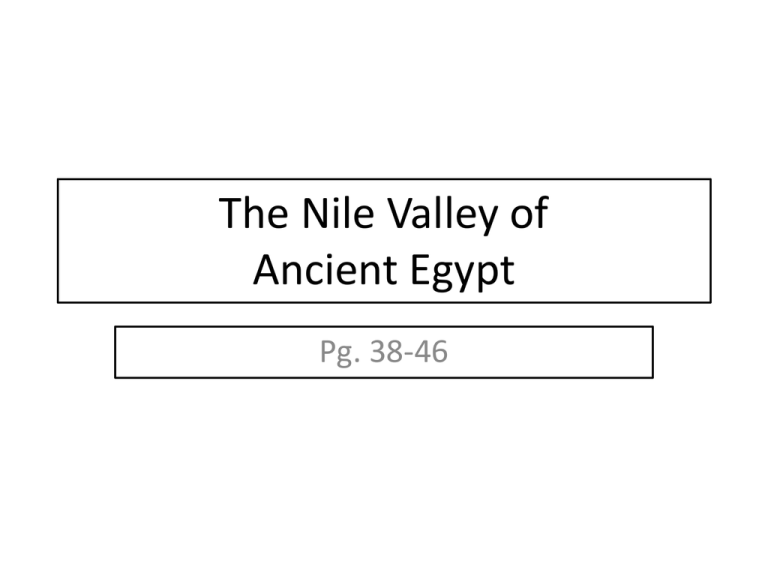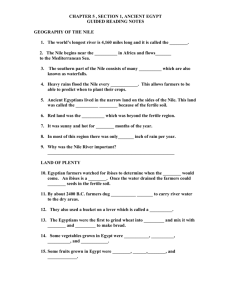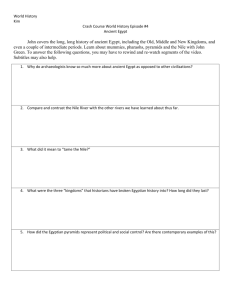The Nile Valley - Mr. Taylor
advertisement

The Nile Valley of Ancient Egypt Pg. 38-46 Vocabulary Vocabulary • Cataract-Steep/wild rapids created by cliffs and boulders. • Delta-End of a river that branches out over an area of fertile soil. • Papyrus-Reed like plant that grows along the Nile used to make baskets, sandals, rafts, and paper. • Hieroglyphics-Egyptian writing system using picture and sound symbols. • Dynasty-A line of rulers from one family Settling the Nile • Between 6000 BC/BCE and 5000 BC/BCE people began to settle the Nile River Valley for its fertile land. They became known as Egyptians. (What time period is this) A Mighty River • Area lacks rainfall, so the Nile River is relied on. • It was used for drinking, bathing, irrigation, cooking. Provided fish and supported plant and animal life. • Egyptians view the Nile as a precious gift. Settling the Nile • Today: World’s longest river, over 4,000 miles long. Flows north from high lands of Central Africa to the Mediterranean Sea. • Much of the Nile is filled with cataracts, narrow cliffs and boulders that form wild rapids. • Large ships only use the last 650 miles of the Nile. Nile River Cataract Settling the Nile A Sheltered Land • The Nile creates one of the largest deltas in the world. • A delta is an area of fertile soil at the mouth of a river. • On both sides of the Nile there is desert. • To the west is the largest desert in the world, the Sahara. Settling the Nile • To the east is the Eastern Desert. • Deserts served a purpose: Kept enemies out of Egypt. • Other geographic features of protection: Cataracts of the Nile, delta marshes, Mediterranean Sea, and Red Sea. • Nile was/is used for trade and transportation. Nile River Delta Note the branching out! Why is it GREEN in the delta? The River People Regular Flooding • Egyptians had to cope with river flooding. • Floods caused by heavy rains in Central Africa and melting snows in the highlands. • Floods left dark, fertile mud which made the land fertile. How did Egyptians use the Nile? • Took advantage of floods. The River People • Planted wheat and barley. • Used the water for irrigation. • Developed geometry to survey land that flood waters washed out. • Used papyrus, a plant along the Nile, to make baskets, and rafts. It was also used as paper. What are Hieroglyphics? • A way of communication for the Ancient Egyptians. • A creation of picture symbols that stood for sounds and words became known as hieroglyphics. Papyrus Paper made of Papyrus The River People • Few people could read and write in Ancient Egypt. • Those that could were often scribes, or record keepers for the rulers, priests, and traders……just like Mesopotamia. United Egypt • Skillful farming led to surplus, or extra, which allowed people to work in other areas. • More good became available, resulting in more trade between Egyptians. Rise of Government • Because of a growth in population and increased disputes of land ownership government had to be formed. United Egypt • Gradually government grew to overlook the people and decisions to be made. Early Egyptian Life Egypt’s Social Classes • Three classes: Upper, middle, and low. • Upper: Priests, government officials, and the wealthy. These people had elegant homes and wore jewelry. • Middle: People who ran businesses, such as farmers, traders, shopkeepers, and scribes. • Low: Unskilled workers, those who unloaded boats, stacked mud bricks, or did physical labor. Early Egyptian Life Family Life • Father headed the family. • Egyptian woman had many rights, such as own property, buy/sell goods, and obtain divorces. • Few went to school. • Mothers taught daughters to sew, cook, and run the house. • Fathers taught sons to farm and skilled trades. • Children played with board games, dolls, and stuffed leather balls. Compare/Contrast • How was/is Ancient Mesopotamia and Ancient Egypt similar? Give some examples. • How was/is Ancient Mesopotamia and Ancient Egypt different? Give some examples.





